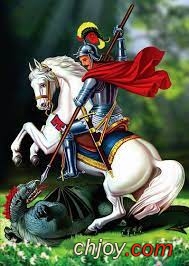
 |
 |
 |
 |
|
|
|
رقم المشاركة : ( 1 )
|
|||||||||||
|
|||||||||||
|
تذكار القديس جرجس الشهيد/23 نيسان  وُلِد هذا القديس في مدينة اللد بفلسطين سنة 280 من أسرة مسيحية شريفة . توفي والده فربّته أمّه التقيّة تربية مسيحيّة صحيحة. ولما بلغ السابعة عشرة دخل في سلك الجنديّة وترقي الى رتبة قائد ألف. قال المؤرخ أوسابيوس في استشهاده: لما شدد ديوكلتيانس قيصر في اضطهاد المسيحيّين وأصدر بذلك أمرًا علقه على جدار البلاط الملكي في نيكوميدية، تقدّم جورجيوس ومزّق ذلك الأمر. فقبض عليه الوثنيون فشووه اولاً، ثم البسوه خفًا من حديد مسمرًا بقدميه وسحبوه وراء خيل غير مروضة، فخلصه الله من ذلك كله، ثم طرحوه في أتون مضطرم فلم يؤذه، ولما رأى الملك ديوكلتيانوس هذا المشهد غائصًا في بحر من الدماء لا يئن ولا يتأوه أكبر شجاعته. وعز عليه أن يخسر قائد حرسه وابن صديقه القديم. فأخذ يلاطفه ويتملقه لكي يثنيه عن عزمه ، فأحب جورجيوس أن يبدي عن شعوره بعطف الملك. فتظاهر بالإقتناع وطلب ان يسمح له بالذهاب إلى معبد الأوثان. فأدخلوه معبد الإله "ابلّون" باحتفال مهيب حضره الملك ومجلس الأعيان والكهنة بحللهم الذهبية وجمع غفير من الشعب. فتقدم جورجيوس إلى تمثال ابلّون ورسم اشارة الصليب. وقال للصنم: أتريد أن أقدم لك الذبائح كأنك إله السماء والارض؟ " فأجابه الصنم بصوت جهير:" كلا أنا لست الهًا بل الإله هو الذي انت تعبده". وفي الحال سقط ذلك الصنم على الأرض وسقطت معه سائر الأصنام. وعندها صرخ الكهنة والشعب: أن جورجيوس بفعل السحر حطم آلهتنا. فالموت لهذا الساحر. فصلبوه. ورموه بالنشاب حتى أسلم الروح. فطارت شهرة استشهاده في الآفاق شرقًا وغربًا. وأجرى الله على يده عجائب كثيرة باهرة وأخذ المسيحيّون منذ القرن الرابع يحجّون إلى ضريح الشهيد " اللابس الظفر"، فينالون بشفاعته غزير البركات والنعم. وقد رسم له المصورون صورة رمزية جميلة تمثله طاعنًا برمحه شيطان الوثنية الممثل بالتنين، ومدافعًا عن معتقد الكنيسة الممثلة بابنة الملك السماوي. وقد شيدت على اسمه كنائس ومذابح في جميع الاقطار. واتخذته بريطانيا شفيعًا لها. ودُعي كثير من ملوكها باسمه. ويكرمه الإنكليز إكرامًا عظيمًا. وامتازت فرنسا أيضًا بتكريمه. واتخذته جمهورية جنوا في إيطاليا شفيعها الأول الأكبر. وجمهورية البندقية أنشأت فرقة رهبانيّة عسكريّة على اسمه. صلاته معنا. آمين. St. George It is uncertain when Saint George was born and historians continue to debate to this day. However, his death date is estimated to be April 23, 303 A.D. The first piece of evidence of George's existance appeared within the works of the Bollandists Daniel Papebroch, Jean Bolland, and Godfrey Henschen's Bibliotheca Hagiographica Graeca. George was one of several names listed in the historical text, and Pope Gelasius claimed George was one of the saints "whose names are justly reverenced among men, but whose actions are known only to God." George was born to a Gerontios and Polychronia, a Roman officer and a Greek native of Lydda. Both were Christians from noble families of the Anici and George, Georgios in the original Greek, was raised to follow their faith. When George was old enough, he was welcomed into Diocletian's army. By his late 20's, George became a Tribunus and served as an imperial guard for the Emperor at Nicomedia. On February 24, 303 A.D., Diocletian, who hated Christians, announced that every Christian the army passed would be arrested and every other soldier should offer a sacrifice to the Roman gods. George refused to abide by the order and told Diocletian, who was angry but greatly valued his friendship with George's father. When George announced his beliefs before his peers, Diocletian was unable to keep the news to himself. In an effort to save George, Diocletian attempted to convert him to believe in the Roman gods, offered him land, money and slaves in exchange for offering a sacrifice to the Roman gods, and made several other offers that George refused. Finally, after exhausting all other options, Diocletian ordered George's execution. In preparation for his death, George gave his money to the poor and was sent for several torture sessions. He was lacerated on a wheel of swords and required resuscitation three times, but still George did not turn from God. On April 23, 303 A.D., George was decapitated before Nicomedia's outer wall. His body was sent to Lydda for burial, and other Christians went to honor George as a martyr |
 |
|